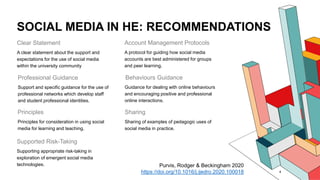Using social media safely and appropriately in higher education.pptx
- 1. 6.53 USING SOCIAL MEDIA SAFELY AND APPROPRIATELY IN HIGHER EDUCATION Sue Beckingham (@suebecks) and Alison Purvis (@DrAlisonPurvis) Sheffield Hallam University
- 2. HISTORY 2013: repeated requests for guidance about social media use, particularly focused on online behaviours. In response we created guidance (https://go.shu.ac.uk/socialmedia) 2015: #SocMedHE15 2
- 3. 2020: in January 2020 we published our research on Experiences and perspectives of social media in learning and teaching in higher education which includes recommendations for HE 2022: ‘post-pandemic’ digital communication skills prevalent and the boundaries that define ‘social media’ now more blurred than ever. We are now in the process of revamping our guidance 3 HISTORY
- 4. SOCIAL MEDIA IN HE: RECOMMENDATIONS Clear Statement A clear statement about the support and expectations for the use of social media within the university community Professional Guidance Support and specific guidance for the use of professional networks which develop staff and student professional identities. Principles Principles for consideration in using social media for learning and teaching. Account Management Protocols A protocol for guiding how social media accounts are best administered for groups and peer learning. Behaviours Guidance Guidance for dealing with online behaviours and encouraging positive and professional online interactions. Purvis, Rodger & Beckingham 2020 https://doi.org/10.1016/j.ijedro.2020.100018 4 Sharing Sharing of examples of pedagogic uses of social media in practice. Supported Risk-Taking Supporting appropriate risk-taking in exploration of emergent social media technologies.
- 5. WHAT HAS CHANGED? • Social media does not have a shared understanding. Several tools for digital communication could be defined as social media and yet would not be universally recognised as such. • The ethics and values relating to using tools is increasingly to the forefront of decision making. • Alternative spaces (i.e., Discord, Snapchat, Signal, TikTok, Mastodon, Zoom, MSTeams) and new terminology (moblog, lifestreaming, webcasting, vlogging, FOMO, splog, astroturfing) • Misinformation and ‘fake news’, the perpetuation of false information which is often difficult to distinguish from well evidenced information. • Artificial Intelligence and bot-generated content. • The university community are still seeking guidance and reassurance in an ever-changing digital environment. 5 “Social media are web-based and mobile services that allow individuals, communities, and organizations to collaborate, connect, interact, and build community by enabling them to create, co-create, modify, share, and engage with content (user- or bot-generated)” Quan-Hasse & Sloan, 2022
- 6. How to use Social Media Responsibly Using Social Media for Learning Using Social Media to Enhance Your Employability • Refresh and simplification. Overall behaviours and considerations of what is ‘responsible’ unchanged. • Main change: ‘post’ (content) amended to ‘share’ to encompass more digital communication tools & alternative spaces GUIDANCE: NEW FEATURES Social Media and Digital Communication Tools • Critical thinking for safe decision-making • Ethical and values-based considerations • Data sharing and granting permissions • Evaluating authenticity of content • New benefits identified • Digital confidence and capability • Ability to try new tools and critically analyse their value, ethics, and risk. • How to develop an outward facing professional profile.
- 7. Purvis, A.J., Rodger, H.M. and Beckingham, S. (2020). Experiences and perspectives of social media in learning and teaching in higher education. International Journal of Educational Research Open, 1, 100018. https://doi.org/10.1016/j.ijedro.2020.100018 Quan-Hasse, A., and Sloan, L. (2022). The SAGE Handbook of Social Media Research Methods. 2nd Edition, SAGE. THANK YOU REFERENCES
Editor's Notes
- 2 min
- 2 min (1 min each) AP Nursing, health, social care staff requests, professionalism Highest priority was placed on student guidance for responsibility and safety, followed by broad-brush guidance in social media in learning and teaching, and case studies for teaching staff along with forums for discussing practice and feeding into guidance. A cross institutional group should be established to develop staff facing guidance and to share approaches that ae specific to the different business needs of the university, so reducing duplication, encouraging openness and appreciation of the diversity of use cases. SB SocMedHE15
- 2 min (1 min each) AP – 2020 SB – 2022
- 3 min AP
- 3 min SB One definition “Social media are web-based and mobile services that allow individuals, communities, and organizations to collaborate, connect, interact, and build community by enabling them to create, co-create, modify, share, and engage with content (user- or bot-generated)” Anabel Quan-Hasse and Luke Sloan, The SAGE Handbook of Social Media Research Methods, 2022.
- 3 min AP – how to use SM responsibly (1 min) SB – SM for learning and employ (2 min) CC license Research and evaluation






